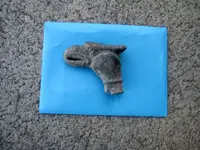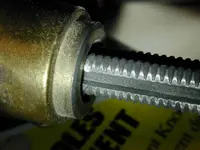Greetings,
I would suggest you take the dagger to a museum and ask them to identify it. To my eye, it does look Saxon or even Roman in origin, but it is not possible to tell for certain from photographs alone.
Tinpan wrote: Most ancient world empires, in my opinion had neither the navagation skill or the type of ship to cross the ocean to America.
Tinpan, have you researched the matter? The people of ancient times (classical age to early Iron age) were not the coast-hugging rafters of the stone age or the Medeival period when the state of knowledge and navigation had fallen considerably. Of the ancient empires, the Phoenicians and their western cousins Carthaginians were the experts of their day, the best in the world; even the skeptic concedes that they had sent out ships on voyages of exploration into the Atlantic, Indian and Pacific oceans, bringing spices like cinnamon, cloves, cassia from faraway SE Asia to trade in the Mediterranean - they circumnavigated Africa circa 600 BC, explored up the Nile river, traded for tin in the British isles and amber in the Baltic. There are ancient texts which support the idea that some kind of contact taking place - read Aristotle's somewhat obscure book "On Marvelous Things Heard" or Plutarch's Moralia XII, Diodorus Siculus and others - not only were these people aware that the world is spherical in nature, but they were aware of the existence of the Americas too. One of the most over-looked passages in Plato's tale of Atlantis proves this too - quote "
This power came forth out of the Atlantic Ocean, for in those days the Atlantic was navigable; and there was an island situated in front of the straits which are by you called the Pillars of Heracles; the island was larger than Libya and Asia put together, and was the way to other islands, and from these you might pass to the whole of the opposite continent which surrounded the true ocean; for this sea which is within the Straits of Heracles is only a harbor, having a narrow entrance, but that other is a real sea, and the surrounding land may be most truly called a boundless continent.
(from Timaeus by Plato)
There are also solid evidences of contact taking place in ancient times as well - a number of Egyptian mummies were found to have ingested tobacco and nicotine when tested, American products; American peanuts were found in an ancient Chinese tomb dating to the second century BC, Old World cotton was found being cultivated by Amerindians when first discovered by Europeans; American corn is depicted on ancient Indian (as in Asia) statues, chickens were found being raised by Amerindians too, and many more products which prove that SOME kind of contact was taking place such as bottle gourds, peppers, and hemp. Does this mean that there were Roman legions marching around in Indiana? No of course not - in fact the most likely agents of such contact were Phoenicians and Carthaginians, and the level of contact was sporadic and relatively small. There are also ancient Punic and Phoenician shipwrecks found in the Americas too, including one off Bimini which was examined by a Yale professor who pronounced it Phoenician and dating to 1200 BC, a Punic wreck off the coast of Honduras and another in the Bay of Jars in Brazil as well as one found "deeply buried in sand" in Mexico.
Does this prove that the dagger must then be Roman? No obviously not - but it is not impossible; there is a possible Roman wreck off the coast of Massachusetts which has been casting Roman coins ashore for many years. Iron objects do sometimes survive in the ground for a surprising length of time - in my own collection I have several iron arrow points and spear points (including one Roman that is nearly a foot long) though they do not survive as well as bronze items. Even if the dagger were proven to be Roman or Saxon, it could well have been lost in the 1700s or 1800s, which would be long enough for what ever material made up the rest of the handle to rot away. Some mighty strange things have been found in the Americas though, (if you are curious, do a google on Calalus) including things which are not "supposed" to have been here including weapons, amphora, coins, oil lamps, even statues.
Is that knob on the end threaded on, or hammered on?
A VERY cool find, please keep us informed as to what you learn about it? Thank you in advance,
Oroblanco
 It's an early Christmas present to myself.)
It's an early Christmas present to myself.)  It's an early Christmas present to myself.)
It's an early Christmas present to myself.) 








